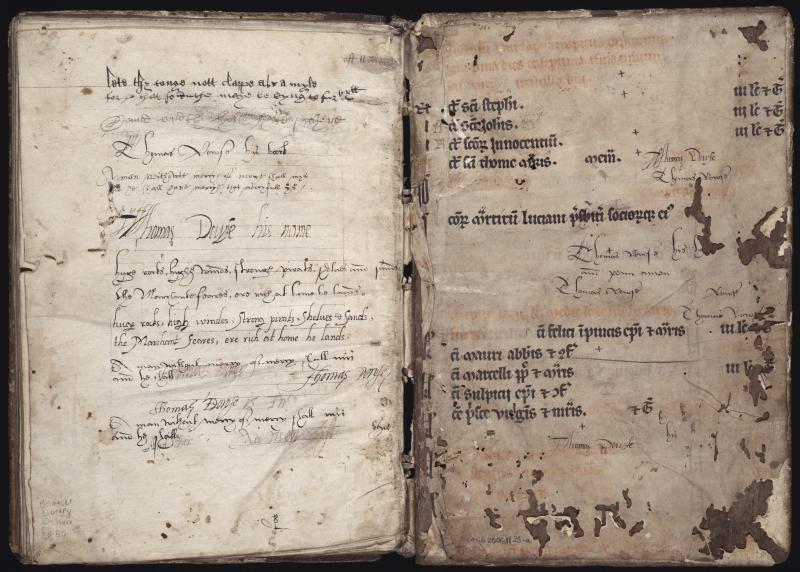Terms of use
The Beinecke Rare Book and Manuscript Library has graciously contributed the above images from their collections to Shakespeare Documented, and retains sole ownership of said images. Visitors may download, link to and cite the image within Shakespeare Documented in personal research, and for publication. For the full range of permissions, please review the Beinecke’s Permissions and Copyright page. Any further use, including, but not limited to, unauthorized downloading or distribution of the image is strictly prohibited. Visitors must contact the Beinecke to request additional use, at: Beinecke.library@yale.edu.
Document-specific information
Creator: Peter Idle
Title: Instructions to his son.
Date: 16th century
Repository: Beinecke Rare Book and Manuscript Library, New Haven, CT, USA
Call number and opening: Osborn fa50, endpapers
View online bibliographic record
Adam G. Hooks, "Thomas Dowse's manuscript note from Lucrece in Peter Idle's 'Instructions to his son,'" Shakespeare Documented.
Beinecke Rare Book and Manuscript Library, Osborn fa50. See Shakespeare Documented.
Two annotations written on the endpapers of a manuscript book may – or may not – be an early quotation of Shakespeare. This late 15th century manuscript copy of Peter Idle’s Instructions to his son was once owned by Thomas Dowse, who repeatedly inscribed his name in a formula often used by early modern readers: “Thomas Dowse his book” and “Thomas Dowse his name.” On the same page, Dowse also copied two lines which can be found in Shakespeare’s Lucrece, first published in 1594.
Dowse’s interest in copying out these lines seems to have been both a matter of handwriting practice (hence the repetition) and commonplacing – that is, extracting useful and appropriate lines which have some relevance to one’s own interests. Dowse practices two different scripts: he first writes his name in secretary followed by italic, and copies the Lucrece lines in both scripts as well.
The excerpt is copied out twice, with only minimal changes:
huge rocks, huge winds, strong pirats, shelues and sands,
the Marchante feares, ere rich at home he lands.
huge rocks, high windes, strong pirats, shelues & sands,
the Marchant feares, ere rich at home he lands.
The lines describe the difficulties that must be confronted and surmounted in order to achieve success: the merchant fears storms, pirates, and other impediments which imperil his cargo, before landing safely at home where he earns and enjoys his riches. This rhyming couplet is just the kind of instructional maxim that would appeal to an active (and perhaps ambitious) reader.
The early editions of Lucrece include commonplace markers – sets of inverted commas that draw attention to lines that are particularly quotable – and so the text as a whole is marked as a suitable source for commonplacing. Shakespeare’s pair of narrative poems, Lucrece and Venus and Adonis, were especially attractive to readers. For example, excerpts from the two poems far outnumber those taken from Shakespeare’s plays in a series of printed commonplace books sponsored by John Bodenham at the turn of the seventeenth century, including Bel-vedere and Englands Parnassus. These books collected extracts from the works of contemporary writers, and organized them under topical headings. Thus removed from their immediate poetic or dramatic context, the passages were transformed into memorable maxims that could be used and applied by readers in a variety of circumstances.
In the poem’s context, however, the maxim means something far more sinister. The couplet concludes a stanza in which Tarquin quotes two different maxims in order to strengthen his resolve and to overcome the obstructions he encounters before entering Lucrece’s chamber – where he will commit the crime that the running title on the page reiterates: “THE RAPE OF LUCRECE.” Shakespeare deliberately inserted this sententious aphorism into his poem, demonstrating the practice of commonplacing – the application of a general statement to a particular situation – while at the same time demonstrating the potential misuse and abuse of the practice by giving the lines to Tarquin.
Dowse did not need to consult a copy of Shakespeare’s poem in order to find these lines, however. The couplet is quoted in Bel-vedere (p. 144) in the section “Of Feare,” where it conveniently appears at the bottom of the page facing the subject heading.
In another annotation on a different page, Dowse copied out an extract from a famously sententious poem by William Warner, Albions England. This rhyming couplet was included in Englands Parnassus, where it is attributed to Warner – although Dowse does not attribute any of the quotations he transcribed in his book.
Was Thomas Dowse an early reader of Shakespeare? Or was he simply an active reader who found the maxim in a printed commonplace book? It is impossible to know, but one thing is certain: the unattributed lines copied by Dowse have nothing to do with Shakespeare’s authorship or reputation. Dowse’s interest was in the sententious quality of the couplet, rather than its contextual source in Shakespeare’s poem. Even if Dowse was not thinking (or was even aware) of Shakespeare, his act of transcription demonstrates the ways in which Shakespeare’s texts were circulated and valued.
Written by Adam G. Hooks. Adapted from Adam G. Hooks, “Re-membering Shakespeare”
Sources
David Scott Kastan and Kathryn James, Remembering Shakespeare (Beinecke Rare Book & Manuscript Library, Yale University Press: 2012).
Adam G. Hooks, “Re-membering Shakespeare” <http://www.adamghooks.net/2012/04/re-membering-shakespeare.html>
Last updated January 20, 2020










